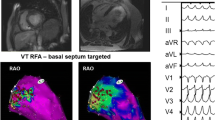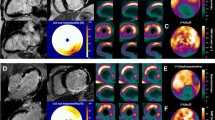Abstract
Purpose
Hibernating myocardium (HM) is associated with sudden cardiac death (SCD). Little is known about the electrophysiological properties of HM and the basis of its association with SCD. We aimed to electrophysiologically characterize HM in patients with ventricular tachycardia (VT).
Methods
Endocardial voltage mapping, metabolic 18FDG-positron emission tomography (PET) and perfusion 82Rb, 201Tl, or 99mTc scans were performed in 61 ischemic heart disease patients with VT. Hibernating areas were identified which was followed by three-dimensional PET reconstructions and integration with voltage maps to allow hybrid metabolic-electro-anatomic assessment of the arrhythmogenic substrate.
Results
Of 61 patients with ischemic heart disease and refractory VT, 7 were found to have hibernating myocardium (13%). A total of 303 voltage points were obtained within hibernating myocardium (8.2 points per 10 cm2) and displayed abnormal voltage in 48.5 and 78.3% of bipolar and unipolar recordings, respectively, with significant heterogeneity of bipolar (p < 0.0001) and unipolar voltage measurements (p = 0.0004). Hibernating areas in 6 of 7 patients contained all three categories of bipolar voltage-defined scar (<0.5 mV), border zone (0.5–1.5 mV), and normal myocardium (>1.5 mV). The characteristics of local electrograms were also assessed and found abnormal in most recordings (76.6, 10.2% fractionated, 5.3% isolated potentials). Exit sites of clinical VTs were determined in 6 patients, of which 3 were located within hibernating myocardium.
Conclusions
Hibernating myocardium displays abnormal and heterogeneous electrical properties and seems to contribute to the substrate of VT. These observations may underlie the vulnerability to reentry and SCD in patients with hypoperfused yet viable myocardium.




Similar content being viewed by others
Abbreviations
- SCD:
-
Sudden cardiac death
- HM:
-
Hibernating myocardium
- VT:
-
Ventricular tachycardia
- VF:
-
Ventricular fibrillation
- IHD:
-
Ischemic heart disease
- MI:
-
Myocardial infarction
- PET:
-
Positron emission tomography
- SPECT:
-
Single photon emission tomography
- 18FDG:
-
18-fluorodeoxyglucose
- ICD:
-
Implantable cardioverter-defibrillator
- PES:
-
Programmed electrical stimulation
- LV:
-
Left ventricle
- RV:
-
Right ventricle
- ICE:
-
Intra-cardiac echocardiography
- IQR:
-
Interquartile range
References
Myerburg RJ, Junttila MJ. Sudden cardiac death caused by coronary heart disease. Circulation. 2012;125:1043–52.
Deo R, Albert CM. Epidemiology and genetics of sudden cardiac death. Circulation. 2012;125:620–37.
EHRA/HRS Expert Consensus on Catheter Ablation of Ventricular Arrhythmias. Heart Rhythm. 2009; 6: 886–933.
Allman KC, Shaw LJ, Hachamovitch R, Udelson JE. Myocardial viability testing and impact of revascularization on prognosis in patients with coronary artery disease and left ventricular dysfunction: a meta-analysis. J Am Coll Cardiol. 2002;39:1151–8.
Di Carli MF, Maddahi J, Rokhsar S, Schelbert HR, Bianco-Batlles D, Brunken RC, et al. Long-term survival of patients with coronary artery disease and left ventricular dysfunction: implications for the role of myocardial viability assessment in management decisions. J Thorac Cardiovasc Surg. 1998;116:997–1004.
Canty Jr JM, Suzuki G, Banas MD, Verheyen F, Borgers M, Fallavollita JA. Hibernating myocardium: chronically adapted to ischemia but vulnerable to sudden death. Circ Res. 2004;94:1142–9.
Borgers M, Ausma J. Structural aspects of the chronic hibernating myocardium in man. Basic Res Cardiol. 1995;90:44–6.
Elsasser A, Schlepper M, Klovekorn WP, Cai WJ, Zimmermann R, Muller KD, et al. Hibernating myocardium: an incomplete adaptation to ischemia. Circulation. 1997;96:2920–31.
Fernandez SF, Ovchinnikov V, Canty Jr JM, Fallavollita JA. Hibernating myocardium results in partial sympathetic denervation and nerve sprouting. Am J Physiol Heart Circ Physiol. 2013;304:H318–27.
Lim H, Fallavollita JA, Hard R, Kerr CW, Canty Jr JM. Profound apoptosis-mediated regional myocyte loss and compensatory hypertrophy in pigs with hibernating myocardium. Circulation. 1999;100:2380–6.
Dilsizian V, Bacharach S, Beanlands S, Bergmann S, Delbeke D, Fischman A, et al. ASNC imaging guidelines for nuclear cardiology procedures: PET myocardial perfusion and metabolism clinical imaging. J Nucl Cardiol. 2009;16:651.
Cerqueira MD, Weissman NJ, Dilsizian V, Jacobs AK, Kaul S, Laskey WK, et al. Standardized myocardial segmentation and nomenclature for tomographic imaging of the heart. Circulation. 2002;105:539–42.
Kitsiou AN, Srinivasan G, Quyyumi AA, Summers RM, Bacharach SL, Dilsizian V. Stress-induced reversible and mild-to-moderate irreversible thallium defects: are they equally accurate for predicting recovery of regional left ventricular function after revascularization? Circulation. 1998;98:501–8.
Srinivasan G, Kitsiou AN, Bacharach SL, Bartlett ML, Miller-Davis C, Dilsizian V. [18F]fluorodeoxyglucose single photon emission computed tomography: can it replace PET and thallium SPECT for the assessment of myocardial viability? Circulation. 1998;97:843–50.
Marchlinski FE, Callans DJ, Gottlieb CD, Zado E. Linear ablation lesions for control of unmappable ventricular tachycardia in patients with ischemic and nonischemic cardiomyopathy. Circulation. 2000;101:1288–96.
Desjardins B, Crawford T, Good E, Oral H, Chugh A, Pelosi F, et al. Infarct architecture and characteristics on delayed enhanced magnetic resonance imaging and electroanatomic mapping in patients with postinfarction ventricular arrhythmia. Heart Rhythm. 2009;6:644–51.
Sasaki T, Miller CF, Hansford R, Yang J, Caffo BS, Zviman MM, et al. Myocardial structural associations with local electrograms: a study of postinfarct ventricular tachycardia pathophysiology and magnetic resonance-based noninvasive mapping. Circ Arrhythm Electrophysiol. 2012;5:1081–90.
Heusch G. Hibernating myocardium. Physiol Rev. 1998;78:1055–85.
Kim SJ, Peppas A, Hong SK, Yang G, Huang Y, Diaz G, et al. Persistent stunning induces myocardial hibernation and protection: flow/function and metabolic mechanisms. Circ Res. 2003;92:1233–9.
Dillon SM, Allessie MA, Ursell PC, Wit AL. Influences of anisotropic tissue structure on reentrant circuits in the epicardial border zone of subacute canine infarcts. Circ Res. 1988;63:182–206.
Downar E, Kimber S, Harris L, Mickleborough L, Sevaptsidis E, Masse S, et al. Endocardial mapping of ventricular tachycardia in the intact human heart. II. Evidence for multiuse reentry in a functional sheet of surviving myocardium. J Am Coll Cardiol. 1992;20:869–78.
Kleber AG, Rudy Y. Basic mechanisms of cardiac impulse propagation and associated arrhythmias. Physiol Rev. 2004;84:431–88.
Bito V, Heinzel FR, Weidemann F, Dommke C, van der Velden J, Verbeken E, et al. Cellular mechanisms of contractile dysfunction in hibernating myocardium. Circ Res. 2004;94:794–801.
Kaprielian RR, Gunning M, Dupont E, Sheppard MN, Rothery SM, Underwood R, et al. Downregulation of immunodetectable connexin43 and decreased gap junction size in the pathogenesis of chronic hibernation in the human left ventricle. Circulation. 1998;97:651–60.
Bonow RO, Maurer G, Lee KL, Holly TA, Binkley PF, Desvigne-Nickens P, et al. Myocardial viability and survival in ischemic left ventricular dysfunction. N Engl J Med. 2011;364:1617–25.
Beanlands RS, Nichol G, Huszti E, Humen D, Racine N, Freeman M, et al. F-18-fluorodeoxyglucose positron emission tomography imaging-assisted management of patients with severe left ventricular dysfunction and suspected coronary disease: a randomized, controlled trial (PARR-2). J Am Coll Cardiol. 2007;50:2002–12.
Gyongyosi M, Dib N. Diagnostic and prognostic value of 3D NOGA mapping in ischemic heart disease. Nat Rev Cardiol. 2011;8:393–404.
Author information
Authors and Affiliations
Consortia
Corresponding author
Ethics declarations
Funding sources
None.
Conflict of interest
Dr Dickfeld receives consulting and grant support from Biosense Webster and grant support from General Electric. All other authors declare that they have no conflicts of interest.
Rights and permissions
About this article
Cite this article
Hussein, A.A., Niekoop, M., Dilsizian, V. et al. Hibernating substrate of ventricular tachycardia: a three-dimensional metabolic and electro-anatomic assessment. J Interv Card Electrophysiol 48, 247–254 (2017). https://doi.org/10.1007/s10840-016-0219-1
Received:
Accepted:
Published:
Issue Date:
DOI: https://doi.org/10.1007/s10840-016-0219-1




